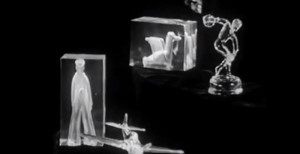An image may be worth more than a thousand words after all. Danish artist Jesper Just’s films shown at Gallerie Perrotin in Paris examine the tension caused by those undelivered promises of possibility, by appointed gender roles and the merciless passing of time and youth. His films use no dialogue and the frustration of their protagonists is expressed through camera movements and sound.
The fact that his films are shown in a gallery adds to the confusion of defining his work as film or art project. Having said that, his cinematic influences are evident in his work. After seeing his film A Vicious Undertow one can identify the artist’s admiration of Bergman’s body of work and his use of silence in conveying the tension between his protagonists. Music, particularly The Moody Blues’ ‘Nights in White Satin’, is whispered by one of the women in the film to narrate the story, while the frustration of aging and fading desirability is explored through the waltz. Two women dance before a man interrupts, taking the younger of the two as his partner, while the older one leaves the room to ascend an endless staircase. This cavorting ménage à trios, filmed in quick shots, demonstrates the melancholy that comes with an awareness of aging; having to retire from center stage, so to speak.

From the fragile and poignant universe of A Vicious Undertow, the artist switches gears and explores gender constructs in the intense urban environment of Detroit for Sirens of Chrome. Four African-American women drive around the deserted streets of the Motor City. The quiet in the car mirrors the desolate surroundings, as well as the tensions between them. On arrival at an abandoned theatre converted into a parking lot, a strange confrontation begins with another woman through choreographed movement. The story never reaches a conclusion but the subtle actions of the people in the car and the sound of the body bouncing on the metal of the cars, reflects the dynamic of female relationships and the stereotypes surrounding gender and race.

From an abandoned metropolis to a city that could have existed but never did, Llano features the ghost town, Llano del Rio, that never lived for lack of a water supply. As you can imagine water is as much the protagonist of Just’s film, as it is the defining factor turning utopia to dystopia. Among the dry pipes and ruins a woman tries to prevent a collapse by replacing fallen rocks, symbolizing humanity’s persistence and hope to save what is apparently unsalvageable. The difficulty of letting go of this promised Paradise is masterfully shown through the simple act of putting a stone back in its place.
Jesper Just is showing at Galerie Perrotin in Paris from Saturday, April 20 to Saturday, June 15, 2013.



























